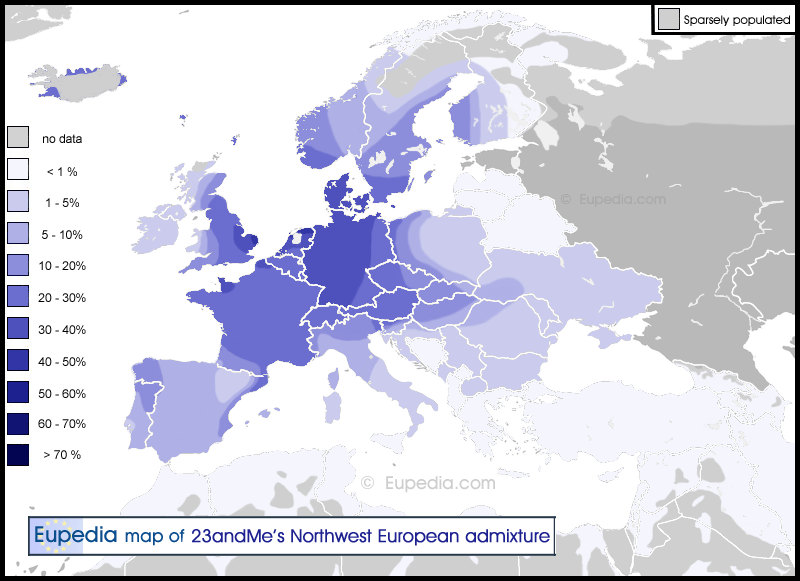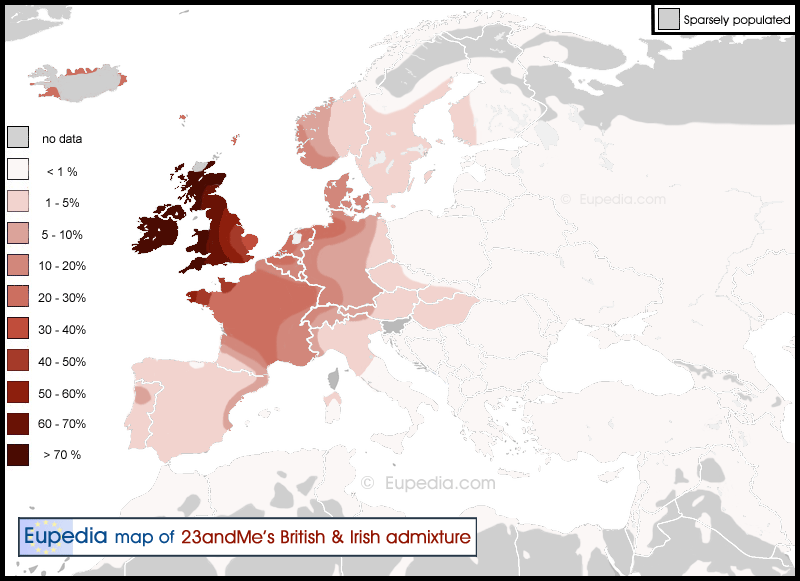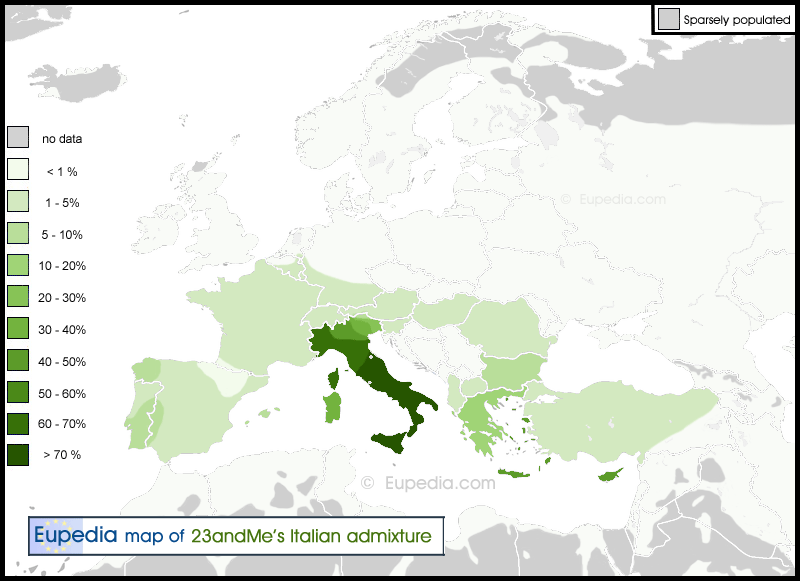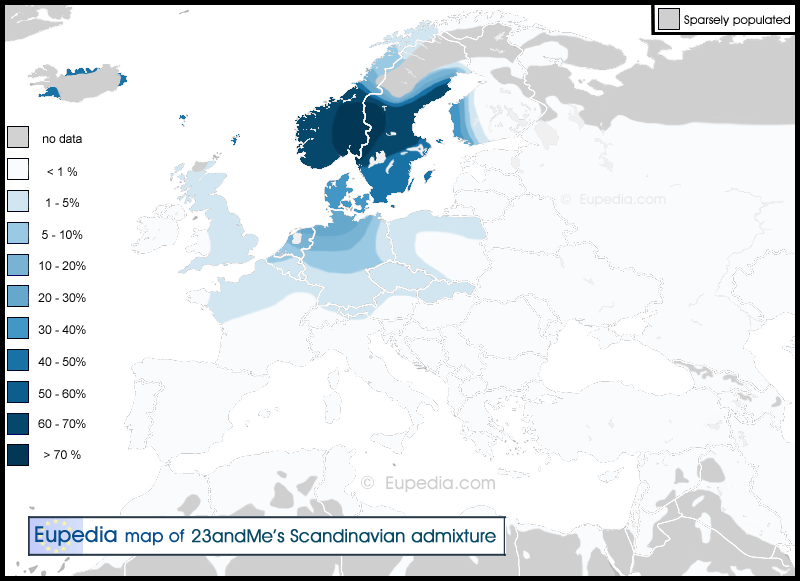DNA Europe
The following maps were created based on the data from the Dodecad Project, Eurogenes, and 23andMe.
Please be aware that the maps are very approximate due to the scantity of regional data available, and the complete lack of data for some countries at present (including the Czech Republic, Slovakia and Slovenia).
Anybody who has taken an autosomal DNA test can check their own Dodecad or Eurogenes admixture by running their raw data through a calculator.
Broadly Northwest European admixture
This admixture peaks in the northern Dutch provinces of Frisia and Groningen (40%), as well as in East Anglia (35-40%), Denmark (34%), the central Netherlands (32%), Germany (31%) and the northern French département du Nord (31%) and the Cotentin peninsula in Normandy (33%). Its distribution correlates mostly with West Germanic ancestry, but could also include some broader Celto-Germanic elements in Germany, the Benelux and France. It appears to be linked to the Proto-Celto-Germanic Y-haplogroup R1b-U106, which almost reaches its maximum frequency in Frisia, East Anglia and Denmark. The higher percentage in northern Portugal and Galicia can be attributed to the Suebi settlements in the early Middle Ages.
Distribution of the Broadly Northwest European admixture in Europe

British & Irish admixture
This admixture appears to have been created by combining the Insular Celtic (ancient Gaelic and Brythonic) ancestry linked to Y-haplogroup R1b-L21 with the specifically Anglo-Saxon and Frisian clades of Y-haplogroup R1b-U106. However this admixture is found everywhere in Western Europe, from Iberia to Scandinavia and could be described as broadly Celto-Germanic. In other words it includes Indo-European DNA brought by the R1b migrations in the Bronze Age minus the admixture from the French & German and the Broadly Northwest European. Since almost all Irish ancestry is either Insular Celtic or Anglo-Saxon, it reached a maximum frequency of 95% in Ireland (and possibly in Wales too). The higher frequency in the Netherlands and Northwest Germany, and the presence in northern Italy and northern Sardinia suggests that this admixture was also found among the Anglo-Saxons and Lombards. The high frequency in France could also be due to a dual Celto-Germanic origin.
Distribution of the British & Irish admixture in Europe

French & German admixture
This admixture could represent ancient Alpine Celtic ancestry from the Hallstatt and La Tène cultures, perhaps mixed with some Germanic ancestry (notably Frankish and Alemani/Suebi). It peaks in Switzerland (max. 65%) and Wallonia (max. 70%), which were the two centres of the La Tène culture. The map matches fairly well the distribution of Celtic branches of Y-haplogroup R1b-U152 (once Italic ones are removed).
Distribution of the French & German admixture in Europe

Iberian admixture
This admixture peaks among the wider Basque region, including former Basque speakers in Navarra and Aragon. It is found at a high percentage throughout the Iberian peninsula, but is generally lower in western Iberia and along the Mediterranean coast, where many non-Iberian people have settled throughout history (Phoenicians, Hallstatt Celts, Greeks, Romans, Suebi, Vandals). It is also common among Occitan speakers in the southern half of France, surely due to the Neolithic connection with the Iberian peninsula.
Distribution of the Iberian admixture in Europe

Italian admixture
This map has a distribution that seems to include mostly the non-Celtic/Germanic ancestry in Italy. Despite the heavy ancient Greek colonisation of southern Italy, this admixture is quite distinct from the Greek one, except in the Aegean Islands, Anatolia and Cyprus, where 23andMe doesn’t seem to distinguish between Italian and Greek ancestry. This is because insular Greeks are very close genetically from South Italians. This admixture seems to be found exclusively within the boundaries of the Roman Empire, and consequently might well have been spread outside Italy/Greece by the ancient Romans. The hotspots in Galicia and central/southern Portugal can be explained by the high percentage of Roman colonies in those regions, but also perhaps by the displacement of the substantial Roman population from western Andalusia to Portugal over the centuries.
Distribution of the Italian admixture in Europe

East European admixture
This admixture corresponds fairly well to Slavic and Baltic ancestry related to Y-haplogroup R1a-M458 and R1a-Z280. There is gradient in the Balkans that also macthes that of haplogroup R1a, although the autosomal admixtures fall more quickly with distance from the Slavic homeland.
Distribution of the East European admixture in Europe

Balkans admixture
Distribution of the Balkans admixture in Europe

Scandinavian admixture
This admixture represents relatively recent Scandinavian admixture (less than 2,000 years). During the Migration period, Germanic tribes that originated in Scandinavia would have carried more of it than North German and Dutch tribes like the Anglo-Saxons, Franks and Lombards. Places settled by the Vikings tend to have slightly higher percentages.
Distribution of the Scandinavian admixture in Europe

Maps from Eupedia